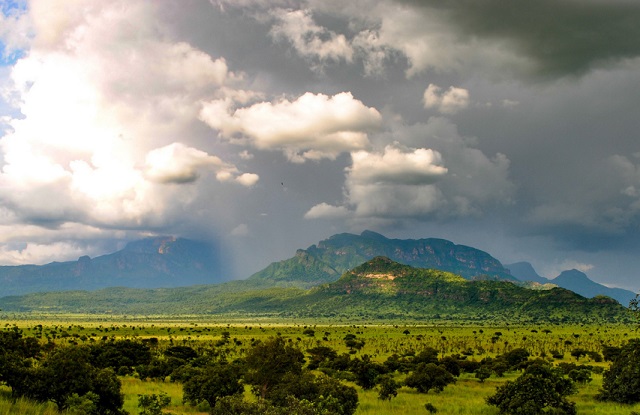
UWA and Space for Giants give hope to Uganda’s most picturesque tourist spot
Kampala, Uganda | RONALD MUSOKE | The Uganda Wildlife Authority (UWA) and conservation non-profit, Space for Giants, have entered into a co-management partnership agreement to revive and promote Pian Upe Wildlife Reserve as one of East Africa’s premier game parks. The game reserve found in the northeastern region of Karamoja is the second largest protected area in Uganda.
The new deal which was signed in the eastern city of Soroti on July 15, and is the first-of-its-kind in Uganda, will see UWA retain the wildlife management forte while Space for Giants, a conservation agency that has over the last 20 years partnered with 10 African governments to unlock investments in their countries’ protected areas, is expected to raise money needed to run the wildlife reserve on a day-to-day basis.
John Makombo, UWA’s director of conservation signed on behalf of UWA while Dr. Max Graham signed on behalf of Space for Giants under the watchful eyes of the Chief Administrative Officers of Amudat, Bukedea, Bulambuli, Katakwi, Kumi, Kween, Nabilatuk, Nakapiripirit and Napak– the districts that neighbour this game reserve.
Makombo said the agreement is a major step in the sustainable conservation of the reserve. “We hope to get more benefits for the local communities which will strengthen our collaboration with partners to commit to conservation.”
“If everyone plays their part, there will be visible benefits to the communities,” he said.
Dr Max Graham, the Founder and CEO, Space for Giants noted that his organization has over the last seven years collaborated with the government of Uganda in the area of conservation. He expressed his confidence in the partnership with UWA, the District Local Governments and the Pian Upe Community Wildlife Association.
“Through this co-management partnership, the Ugandan Government sets in motion the process to fully restore Pian Upe as one of East Africa’s premiere Parks,” he said.
Graham said in addition to investing in Pian Upe’s exceptional natural habitat and the conservation of its biodiversity, the co-management agreement also enhances Pian Upe’s value for local communities and its economic contribution to the country.
It is not yet clear how much money is required to resuscitate Pian Upe although a figure of around US$ 8 million has been mentioned by senior government officials. However, a source close to Space for Giants told The Independent that the non-profit is yet to work out a detailed budget of how much is needed to run the park.
“Space for Giants has to work out what’s needed first, then raise it, then spend it,” the source said.
Once the money is mobilized, it will be used for securing the wildlife reserve, investing in community enterprises, scaling up law enforcement, fire management, conducting wildlife censuses and ultimately re-introducing key species.
Space for Giants will present a business plan to the initiative’s board within six months setting out in detail its approach and budget.
It is expected the finance will come primarily through selling carbon offsets, under a carbon project that has already been launched and seeks to secure the initial funding required to execute the project. Space for Giants will also seek complementary philanthropic support for the project.
Whenever the decision is made, communities from the neighbouring nine districts in eastern Uganda and wildlife reserves will see significantly improved economic and ecological benefits under this pioneering new conservation investment agreement.
More than 150,000 people live in the area surrounding Pian Upe. Jobs and business opportunities arising from the reserve’s rejuvenation are expected to go to locals first.
Endeared birding hotspot
George Owoyesigire, the Acting Commissioner in charge of wildlife conservation at the Ministry of Tourism, Wildlife and Antiquities told The Independent on July 29 that Pian Upe’s lowland rangeland nature presents an opportunity for the visitors to see unique attractions.
Established in 1964, the game reserve is renowned for having one of the most charming expanses of distinct wildlands in the country, dominated by plateaus carpeted by both green and golden intact wooded savannah plains. It is also surrounded by mountains.
Although it falls under the second tier of protected areas in the country, Pian Upe Wildlife Reserve is the second largest protected area in Uganda, just behind the more popular Murchison Falls National Park. It spans a land area of 2,043 sq km and is described by those who have had the chance to visit it as one of the most picturesque tourist spots in the country.
Its plains are dominated by thatching grass although it also features bristle species, lemon grasses, and beard grasses. The sweeping plains are decorated with red acacia, desert date, bush willows and shrubs.
It is said to host 525 recorded bird species and 163 mammals including Uganda’s widest diversity of plains mammals, including the cheetah, the endangered African wild dog, a rare sub-species of roan antelope, and the Rothschild giraffes.
The reserve is also home to varied species of reptiles including venomous puff adders, savannah monitor lizards, common agama, chameleons, skinks and rock pythons. Crocodiles have also been sighted in River Girik which flows through the southern part of this park.
Pian Upe’s ecosystem also attracts unique bird species which makes it an endeared birding hotspot on the Uganda Safari itinerary. Some of the birds to look out for include Ostriches (both wild and domesticated), Abyssinian ground hornbills, superb sterlings, Secretary birds; even the Shoebill can be sighted.
Pian Upe also forms part of the stretch of land that is branded the Karimojong pastoral community area with its distinct culture. It also lies in the embrace of three mountains; Mt. Elgon to the south, Mt. Kadam to the northeast and Mt. Napak to the northwest something which guarantees an opportunity for mountain climbers and hikers.
However, local conservationists say Pian Upe’s biodiversity and role in the larger regional ecosystem has over the last few decades been threatened by poaching. For instance, thousands of elephants and rhinos used to roam the reserve, but were lost to poaching.
As a result, the reserve has not been able to generate enough funding to effectively be managed, something which has worsened the threats to its ecosystem resilience, biodiversity and local communities.
Dr. Gladys Kalema-Zikusoka welcomed the new partnership between UWA and Space for Giants saying the revival of the park will eventually benefit everyone.
Zikusoka who has done some conservation work in this game reserve says the animals are quite shy compared to other national parks because they were poached a lot by the Karimojong. “This (timid animals) is not good for tourism,” Zikusoka said.
However, if resources are made available for UWA to carry out more patrols and stop poaching, the animals will get used to people and tourists will visit to see the animals, Zikusoka told The Independent.
The revival of Pian Upe comes at a time when the government has been looking for investors to set up accommodation facilities in Uganda’s so-called tier-2 protected areas (wildlife reserves)—protected areas that have in the past struggled for tourism revenues.
In 2018, Craig Packer, a professor of ecology, evolution, and behaviour at the University of Minnesota told The Independent that Africa’s national parks and game reserves have over the last 100 years been expected to raise enough funding for photographic tourism or sport hunting to cover for the management costs of wildlife conservation.
However, Packer said the true costs of protecting animals are far higher than the revenues from tourism. In western countries, park budgets are usually covered by tax revenues rather than park entrance fees. But in Africa, tax revenues could never cover these expenses, he said.
Yet, according to research done by Space for Giants and presented at the wildlife economy conference in Victoria Falls, Zimbabwe, in 2019, state-owned protected areas are capable of multiplying the revenue they contribute to African economies.
The paper titled, “Building a Wildlife Economy: Developing Nature-Based Tourism in African state protected areas,” spending on tourism, hospitality and recreation could double to more than US$ 260 billion by 2030.
The paper noted that bringing new private-sector investments to under-funded protected areas to capitalize on surging interest in nature-based tourism would help fund conservation without draining state finances, while driving sustainable local and natural development.
“Some protected areas receive only one in every ten dollars they need, as governments grapple with financial shortfalls amid competing priorities like health, education, and infrastructure development,” the paper noted.
“At present, few state protected areas are meeting their potential as engines for growth. This presents a major opportunity for governments. Cared for and sustainably developed, these are national assets that can provide significant financial and social returns now and long into the future,” Dr. Lauren Evans, Space for Giants director of conservation science said.
Owoyesigire told The Independent that with the new developments surrounding Pian Upe, tourists who have been driving the 410km stretch from Kampala through Mbale on their way to Kidepo National Park in the Northeast of the country with little to see in-between can now include the game reserve on their itinerary.
Fredrick Kizza, the Chief Warden at Pian Upe told The Independent on July 29 that the game reserve is looking forward to growing its visitor numbers over the coming years.
Before COVID-19 interrupted tourism, Pian Upe welcomed close to 1,000 visitors per year. That figure fell to almost zero between 2020 and 2021 thanks to the lockdowns that were instituted by the government.
However, there are signs of recovery as security and road infrastructure improve and wildlife populations rebound. In the first quarter of this year, about 300 tourists visited the wildlife reserve.
“If we can get about 50,000 visitors in the next five years, that would be great,” Kizza told The Independent.
****
 The Independent Uganda: You get the Truth we Pay the Price
The Independent Uganda: You get the Truth we Pay the Price



Well written article but unfortunately a glaring omission.
Surprisingly there was no mention made of KOS who have worked passionately and tirelessly in Pian Upe since 2010.